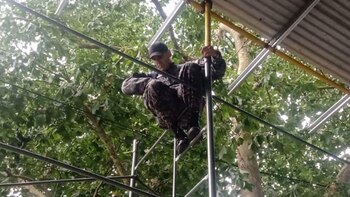We descended to “where no human being had gone”: Chilean scientist Osvaldo Ulloa, who led the expedition that dived 8,000 meters deep off the coast of the South American country in January, tells AFP about the discoveries of new microscopic organisms about which researchers now have more doubts than answers.
Ulloa, director of the Millennium Institute of Oceanography at the University of Concepción, led the group of three people who descended, aboard the Limiting Factor submarine, into the Atacama Trench, a huge gap in the Pacific Ocean that stretches 5,900 km from Ecuador to southern Chile.
“We did the feat of taking human beings to the pit where no human being had ever arrived,” Ulloa says in a telephone interview with AFP.
The “Atacama Hadal” expedition, which was also part of the American explorer Victor Vescovo, and the deputy director of Milenio, Rubén Escribano, began on January 13 and lasted for 12 days off the coast of Mejillones and Tal Tal, in northern Chile.
“At a depth of 100 meters there is no light, which adds to the silence of the depth,” says Ulloa.
It was then necessary to “turn on the powerful LED lights installed outside the submarine capsule”, allowing the group to observe what no human eye had ever seen before.
“We found geological structures and there we saw a type of holoturia or translucent sea cucumbers, like gelatin, that we didn't have registered and that were most likely new species,” explains Ulloa.
“We also discovered bacterial communities that even had filaments that we didn't know existed in the Atacama Trench and that would feed on chemical and inorganic compounds, that opens up a lot of questions: what compounds are those? what kind of bacteria are they?
Faced with those questions, he admits: “We have no idea” about the answers. “We're going to have to go back there.”
The expedition also found species of amphipods (Eurythenes atacamensis) discovered there on an unmanned expedition in 2018, scavenger crustaceans, segmented worms and translucent fish.
“The large population of these organisms found runs counter to what we knew: (which) as the depth increases, the abundance and diversity of organisms decreases,” he added.
- Earthquake “Sensors” —
The Atacama Trench is located in the same place where the Nazca plate and the South American plate collide, two of the tectonic plates that form part of the Pacific belt of fire, cause the earthquakes and tsunamis that frequently occur in this area.
“We will put three sensors on the South American plate and two on the Nazca plate to see how the ocean floor is deformed, (now) these types of sensors only exist on land,” says Ulloa.
“These sensors allow us to know in which area there was no earthquake and (where) energy is accumulating and it is most likely that there will be the next earthquake,” which could help estimate the location of a next earthquake, he explained.
The observatory will begin installation in the second half of this year.
“It's a tremendously ambitious project, the biggest experiment ever done in underwater geology here in Chile,” Ulloa says.
“And there is a lot of interest from the international community to put more sensors and use this region to study all the processes associated with the collision of these two plates,” says the scientist.
MSA/PA/RSR
Últimas Noticias
Debanhi Escobar: they secured the motel where she was found lifeless in a cistern

The oldest person in the world died at the age of 119

Macabre find in CDMX: they left a body bagged and tied in a taxi
The eagles of America will face Manchester City in a duel of legends. Here are the details

Why is it good to bring dogs out to know the world when they are puppies




